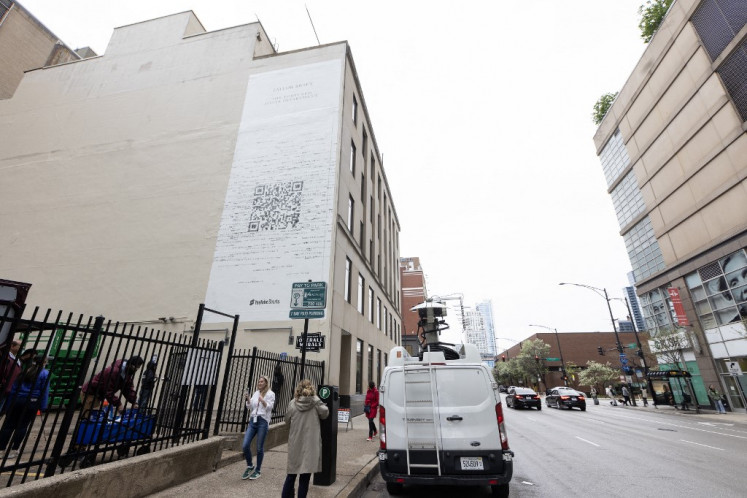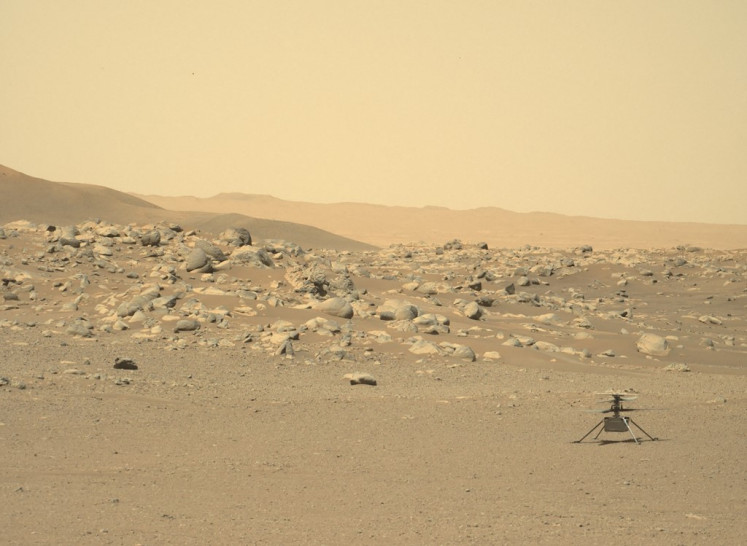Art Bali: A stepping-stone to a sustainable art ecosystem
The most anticipated art exhibition in the island’s recent history, it was Bali’s first venture into the realm of global art events.
Change Size
 'Voice Face', a painting in the Ilusi-Indonesian Idea by Galam Zulkifli (Courtesy of Art Bali/File)
'Voice Face', a painting in the Ilusi-Indonesian Idea by Galam Zulkifli (Courtesy of Art Bali/File)
U
nder wraps Art Bali, a world-class presentation of contemporary art by 39 Balinese, Indonesian and foreign artists in Nusa Dua, closed on Nov. 9. The most anticipated art exhibition in the island’s recent history, it was Bali’s first venture into the realm of global art events.
The origin of Art Bali is the synergy of a relationship beginning in 1998 when Heri Pemad, the CEO and founder of ARTJOG, Indonesia’s flagship contemporary art fair that has evolved into one of the most colorful and unique events on the global art map, and Balinese artist I Made Aswino Aji, were students studying fine art in Yogyakarta.
Heri and Aswino Aji’s discussions began more than 3 years ago laying the event’s conceptual foundations, the catalyst in Art Bali’s realization, however, was Heri’s relationship with the Creative Economy Agency (Bekraf). The opportunity arose when Bekraf head Triawan Munaf presented Heri the challenge of organizing a special event to coincide with the annual meetings of the IMF & World Bank held in Nusa Dua, Bali from Oct. 6 to 19.
According to Heri the Indonesian government was inspired to include an event within the IMF-World Bank side program, the meeting was attended by 34,000 participants from around 200 countries, “They wished to challenge the ideas of delegates visiting Indonesia for the first time that Indonesia was a still a traditional country. Through a presentation of contemporary art dialogue they could observe a nation in a process of development and change.”
Heri's immediate task was to create a branch of Heri Pemad Art Management (HPAM) in Bali with a local team, led by Aswino Aji. After two years of hard work and waiting for the Indonesian governmental bureaucratic process to fall into place, the event was given the green light, which left two months for the physical details of Art Bali to become manifest.
Art Bali was opened by Finance Minister Sri Mulyani on Oct. 9. Held in a purpose built venue designed by Heri and sited within the Nusa Dua tourism precinct in the AB•BC Building, set over 1000 square meters, it was erected in a whirlwind 40 days. “We are pushing Indonesian art onto the new map of the global creative economy,” said Triawan. “We are optimistic that the creative economy will become the backbone of the national economy.”
Global art events in Indonesia that present the finest local and international talent, attracting large national and international audiences, the media, collectors and the art industry have been a feature of the Java art landscape for over a decade. Art fairs, ARTJOG and Art Jakarta have become crucial platforms and meeting points for the Indonesian art world -- the event’s brands now securely positioned on the global art map.
“Art Bali will be an annual event,” Aswino Aji said. “The venue will become a new feature on the Bali landscape, in the pipeline is a series of regular events.”
Read also: ARTJOG 2018 kicks off with new, fresh look
Art Bali, however, is the subject of speculation. If the event continues it could prove to be a vital game changer -- a catalyst within the reconfiguration of an important economic sector that was the initial driver of the tourism economy on Bali almost a century ago.
Art and cultural tourism was responsible for the first wave of tourism to the island beginning in the 1930s, until 1945. In the 1970s during a renewed period of tourism growth art and culture again played defining roles. Post 2008 witnessed the new phenomenon of lifestyle tourism, driven by events such as the Bali Spirit Festival, and the Ubud Readers & Writers Festival, along with the development of resort tourism, as the burgeoning new economic engines. The advancement of new digital technologies as practical and powerful tools has fueled the rapid growth in these thriving sectors.
The lack of local initiative and know-how to build a dynamic and functional infrastructure has, however, resulted in art being almost forgotten within the island’s recent fortunes, with enormous social and monetary potential being unrealized -- and this is where Art Bali becomes essential.
“Our aim is to help build a sustainable art ecosystem in Bali,” Aswino Aji stated.
For a sustainable art ecosystem to evolve three essential fundamentals from the 20th century global art machine must exist within the Bali art landscape; a world-class art fair, museum and auction house, all with international stature. Understanding and prioritizing the need to revive and preserve Bali’s renowned creative traditions is also vital. This may be achieved by a purpose built center for research and development that also focuses on the necessary platforms to launch products and talent into the 21st century global creative economy.
Each year Art Bali must inject fresh and exciting energy into its program, making it very international, with new artists and new works, building its brand beyond Indonesia; first targeting collectors from Southeast Asia, China, Japan and India. Understanding Art Bali’s target audience of national, regional and international art collectors, and being able to lure them to Bali will be one of the keys to its future success. When the above-mentioned key facets of the art infrastructure are in place, the other essentials will organically evolve.
For Art Bali to flourish and become the spearhead of a sustainable art ecosystem, teamwork and collaboration are pivotal, including support from many Indonesian government ministries beyond Bekraf, and likewise the cooperation from the Bali administration. A challenge is how to mobilize the enormous pool of talent from Bali – its artists and art communities.
Art Bali needs to capitalize on the superb international branding power of Bali, while making a clear distinction from ARTJOG by having an event with a strong Bali identity. A vision of how the sustainability of Bali’s art ecosystem can be achieved is possible. Art Bali is the first step in this process. (kes)









